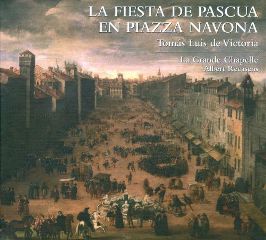Tomás Luis de Victoria - La Fiesta de Pascua en Piazza Navona (2012)
Tomás Luis de Victoria - La Fiesta de Pascua en Piazza Navona (2012)

Disc 1
1. Iubilate Deo, omnis terra (Motette)
2. Domine, quid multiplicati sunt (Salmo)
3. Haec dies quam fecit Dominus (Antífona)
4. Tantum ergo (Himno)
5. Fanfaria
6. Surrexit pastor bonus (Motette)
7. Christo ver'huom' e Dio (Lauda)
8. Ad caenam agni providi (Himno)
9. Ardens est cor meum (Motette)
10. Victimae paschali laudes
11. Ego sum panis vivus (Motette)
12. Iesu, nostra redemptio (Himno)
13. Ricercata La mi re fa mi re sobre el cantus firmus \"Bassa castiglia\" o \"Il re di Spagna\"
14. Expurgate vetus fermentum (Responsorio)
15. Fanfarria
Disc 2
1. Te Deum laudamus (Himno)
2. Tiento de segundo tono por Gsolreut
3. O sacrum convivium (Motette)
4. Victimae paschali laudes (Secuencia)
5. Si tus penas no pruebo (Villanesca)
6. Christus resurgens (Antífona)
7. In exitu (salmi passaggiati) (Salmo)
8. Crucem sanctam subiit (Antífona)
9. Anima mia, che pensi? (Lauda)
10. Regina caeli (Antífona)
La Grande Chapelle
Albert Recanses - conductor
The confraternity of the Resurrection of S. Giacomo degli Spagnoli the Castilian national church in Rome was responsible, from 1579 onwards, for organizing the Easter celebrations in the Piazza Navona, one of the most spectacular public festivities during the time of Spanish supremacy in Italy. This double CD offers a never-before-undertaken evocation of the music that might have been heard in the church and around the square during this most important of Roman celebrations. It brings together an enormously varied selection of vocal and instrumental pieces by composers who, together with Victoria, were either involved in the organization of the festivities (such as Francisco Soto or Ruggiero Giovanelli) or whose music was preserved in the S. Giacomo degli Spagnoli archive. This superb recreation, offering us a new reading of Victoria s work, submerges us in the sonorities that he would have been familiar with in the latter part of his Roman period, from sumptuous polychoral works with Venetian influences to the simple laude spirituali associated with the Oratory of Saint Philip Neri. In short, it is another first for La Grande Chapelle, establishing a context in which to place one of the greatest composers of the Spanish Renaissance. ---Editorial Reviews, amazon.com
In the later decades of the 16th century, the musicians of S. Giacomo degli Spagnoli, the Spanish national church in Rome, were charged with the task of pulling together the performing forces for the Easter celebration, the most important festival in the church year. It was a massive undertaking, with performances outdoors on the Piazza Navona as well as in the churches surrounding the square, involving numerous choirs, orchestras, soloists, organists, instrumental consorts, and brass ensembles, not to mention fireworks and cannons. For this two-disc set conductor Albert Recasens and the chamber orchestra and choir, La Grande Chapelle, have put together a collection of choral and instrumental works that would likely have been included in these Easter spectacles. It's a terrifically diverse group of pieces, including massive antiphonal works that bring the music of Giovanni Gabrieli to mind, a cappella works for men's, women's, and mixed choirs, brass fanfares, keyboard solos, and chamber pieces requiring small vocal and instrumental groups.
Tomás Luis de Victoria, whose music represented the pinnacle of the Spanish high Baroque, was active in Rome during the time of some of these festivals and almost certainly would have had a hand in their planning and execution. The album features several of his motets and hymns, which are very grand examples of genres that in general imply works of a modest scale. The music of Giovanni Pierluigi da Palestrina, the leading Italian composer of the late Renaissance, and Victoria's teacher, is also well-represented. The remaining composers range from the somewhat obscure to the very obscure, but these works, many of them recorded here for the first time, are consistently engaging, and taken all together the album's music is exceptionally lovely. La Grande Chapelle is deployed in various configurations ranging from large antiphonal groups to the most intimate vocal ensembles with one singer to a part. The singers perform with clear, chaste tone, warm blend, shapely phrasing, and obvious feeling for the stylistic conventions of late Renaissance polyphony. The instrumentalists, whether featured in ensembles or in an accompanimental role, play with sensitivity and energy, and are used in wonderfully colorful combinations.
What the modern listener misses in hearing this spatially oriented music in its original context is compensated for by being able to savor it in a clean acoustic environment rather than in the midst of the chaos depicted in a late 16th century engraving of the Easter celebration in the Piazza Navona that is included in the booklet. The exemplary performances on this creatively conceived album are highly recommended for fans of Renaissance polyphony. ---Stephen Eddins, AllMusic Review
download (mp3 @320 kbs):
yandex 4shared mega mediafire uloz.to cloudmailru uptobox ge.tt








